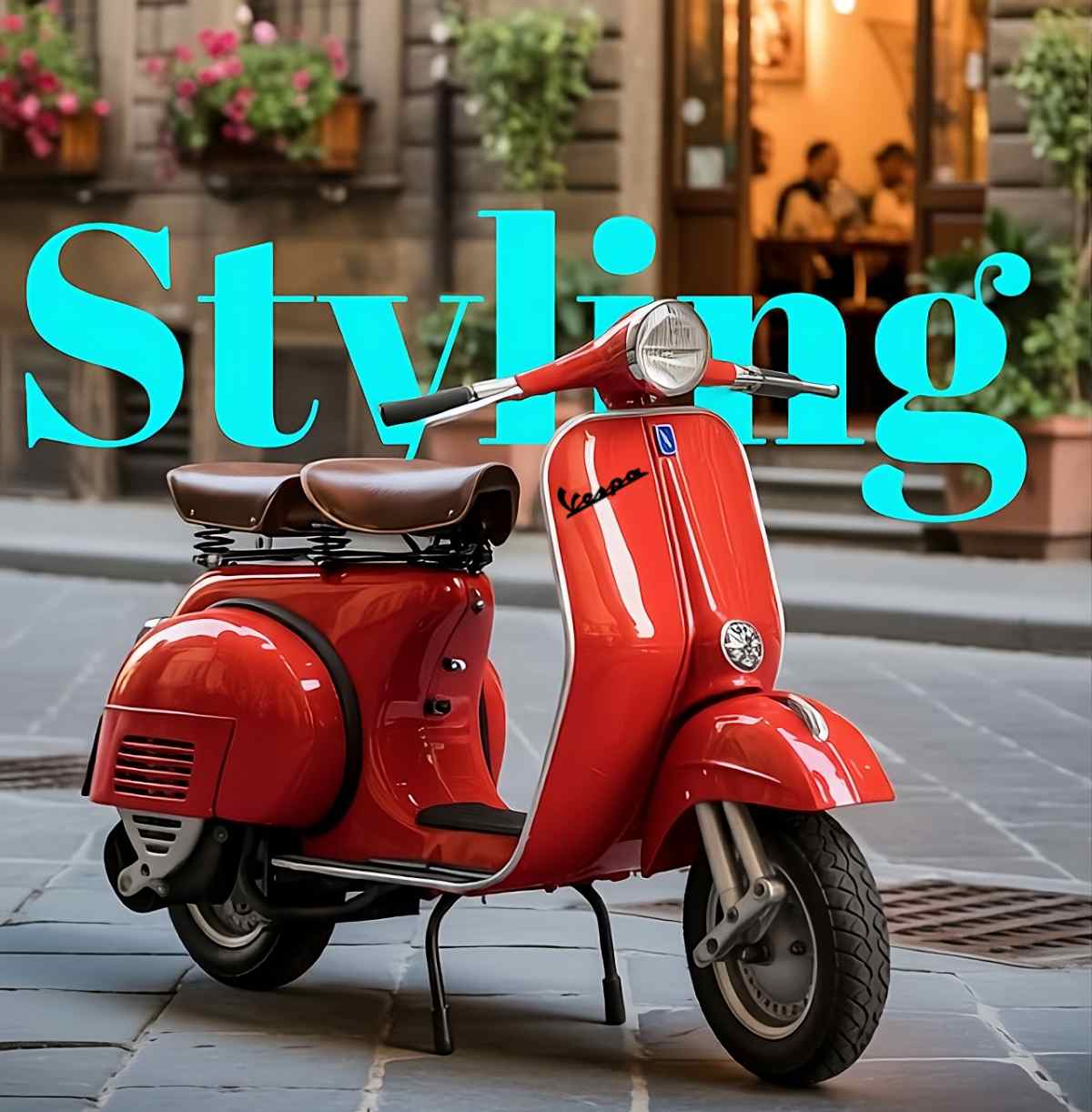- Posted on
- • Modifications
Vintage Scooter Style Guide: Why Classic Curves Beat Modern Design in 2025
- Author
-
-

- User
- Torque
- Posts by this author
- Posts by this author
-

Vintage Scooter Styling & Elegance – Why Old Curves Still Make Us Smile in 2025
1. The Quiet Pull of a Round Headlight
Park a 1965 Vespa next to a brand-new maxi-scooter and guess where the selfies happen. The old bike, every time. The secret isn't speed or price; it's shape. Vintage scooters were drawn with a school compass and a steady hand. The front fender makes a perfect half-moon, the headlight wears a thin chrome ring like a grandfather's watch, and the body tapers to a soft point. No plastic wings, no angry LED brows—just painted steel and a kind, welcoming light.
2. A Tiny History of Pretty Scooters
The foundation of vintage scooter design was laid by iconic models, each adding a unique twist while adhering to a core philosophy of elegance and function.
Key Models That Defined an Era
- 1946 Vespa 98: Piaggio asked an airplane designer to build something “easy on the eye and on stockings.” He hid the greasy bits inside a smooth shell, allowing ladies in post-war skirts to hop on without worry.
- 1952 Lambretta Model C: Innocenti kept the engine in view but added a wrap-around leg shield and a jewel-like badge. This design would later become the canvas for British mods.
- 1960 Heinkel Tourist: The German answer: a 200 cc highway scooter with a fat body and a distinctive two-tone paint stripe running from nose to tail.
- 1965 Vespa GS 160: A sportier iteration with a bigger engine, longer nose, slim waist, and a practical rubber strip to protect the paint when leaning on its stand.
Each model innovated, yet all kept three gentle rules: round headlight, painted body, hidden cables. These rules still define "vintage" today.
3. Little Clues That Shout “Classic”
Certain design cues instantly mark a scooter as a classic. Incorporating these elements is the key to achieving that timeless look.
- Round Headlight in a Chrome Bowl: Square lamps arrived in the seventies and aged fast. The classic round light is eternal.
- Steel Monocoque Body: The skin is the skeleton. With no visible frame, one clean line flows seamlessly from front to back.
- Flat Floorboard with Rubber Strips: Designed for riders in dresses, the strips create a neat rectangle that complements the surrounding curves.
- One Shiny Handlebar: Polished like a classic pub handrail, either fully exposed or tastefully half-hidden.
- Tiny Blinkers and Tail-Lights: Amber lights the size of coins and a tail-light no wider than a matchbox. These small jewels make the big shapes look even more pronounced.
- Body-Colour Wheels: Hubs and rims painted the same shade as the body, making the bike look grounded, low, and calm.
4. Materials That Age Like a Fine Wine
The choice of materials is crucial to the authentic vintage feel and its ability to develop a beautiful patina over time.
Old scooters used painted steel and chromed brass. Steel can be feathered at the edges so joints vanish, while brass maintains a warm shine for decades. Some restorers opt for stainless steel trim for durability, but purists stick with chrome for its faint blue tint, which photographs more softly—a key asset in the Instagram age.
Leather is another critical element. Original seats were made of untreated calfskin; it cracked quickly but matured to a beautiful honey-brown with use. Top-tier restoration shops now hand-dye Italian leather with walnut stain and rub in neatsfoot oil until the surface glows with a rich, deep character.
5. Colours That Never Shout
Vintage colour palettes were chosen for sophistication, not shock value.
Brochures typically offered pastels first, brights second. Think Dove Grey, Sky Blue, or the soft green found on old railway benches. These calm tones let the chrome accents do the sparkling. When brighter shades were introduced—like the Candy Red on a ’64 Vespa—they were always balanced by a white pin-stripe to visually break up the mass. For an authentic look, choose one light base colour, add a fine 3 mm white line along the waist, and leave it at that. Two colours are elegant; three can look busy.
6. New Bikes That Copied the Old Feel
The market has responded to the enduring love for classic design with modern machines that capture the old soul.
- Vespa Primavera 50th (2018): Features a soft grey-blue paint, a leather badge on the seat, and a classic chrome ring around a modern LED headlight.
- Royal Alloy GT 300 (2019): Boasts a traditional steel body, mirror-finished hub caps, and a white-wall tyre option straight from the showroom.
- Lambretta V-Special (2020): A new frame wearing an old dress: round light, side slots echoing the 1968 SX200, and a full-length paint stripe reminiscent of the Heinkel Tourist.
Each of these commands a premium over their plastic rivals, proving that buyers will pay extra for calm curves, even with a brand-new engine.
7. Five Quick Touches to Fake Fifty Years
You don't need a full restoration to capture the vintage vibe. Here are five effective modifications:
- Swap a square headlight for a 150 mm chrome bowl; a modern H4 bulb inside keeps it road-legal.
- Paint the body in one pastel shade and hand-pin-stripe the waist; a 3 mm brush and One-Shot enamel replicate the tiny ridge old painters left.
- Fit narrow white-wall tyres; a 3.00-10 size looks period-correct, while a 120/70-12 looks modern.
- Replace rubber floor mats with thin oak slats held by tiny brass screws; this nods to boat decks and photographs beautifully.
- Strap a leather tool-roll to the rear rack—even if it only holds a rag and a spark plug spanner, it adds a layer of texture that paint cannot.
Implement just three of these, and onlookers will swear your 2020 scooter “must be from the sixties.”
8. Why Soft Shapes Still Matter in 2025
In a world of sharp angles, aggressive styling, and flashing LEDs, a curved fender is a welcome break from the visual noise. Riders of vintage scooters often report that strangers smile more, cabbies let them merge, and café owners offer free coffee “because the bike brightens the corner.” Vintage styling is not just nostalgia; it is visual calm—a polite and graceful wave in an increasingly angry and frantic world.
9. The Takeaway
Vintage scooter elegance rests on three gentle rules: a round light, a painted steel body, and hidden clutter. Keep the colours quiet, the chrome warm, and let the metal speak for itself. Do that, and the little two-stroke will feel larger than its engine size, camera phones will still click, and a crowd will still gather—no matter what year the calendar shows.
